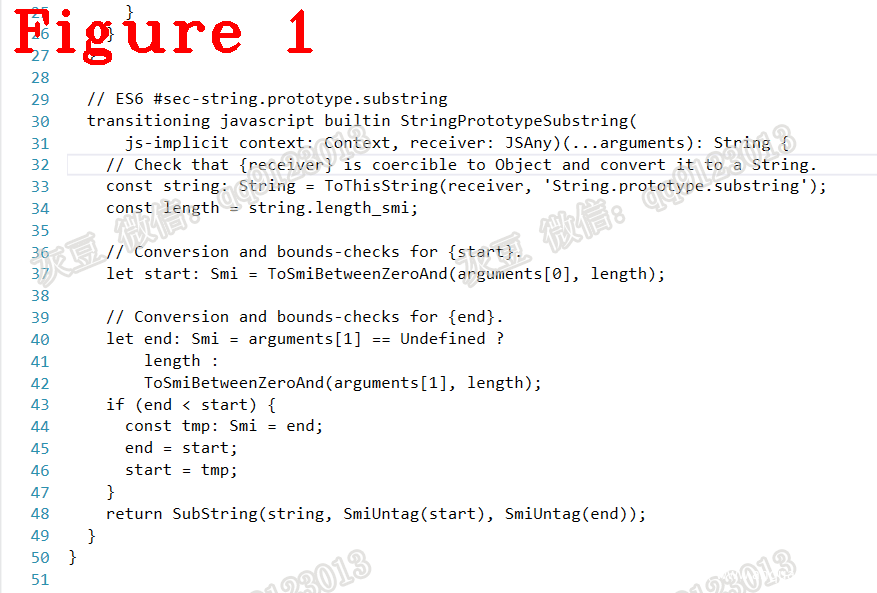1 摘要
本篇文章是Builtin专题的第四篇,主要分析substring的源码。substring有两种实现方法,一种采用CSA实现,另一种采用Runtime实现。本文讲解CSA实现的substring方法以及V8对字符串长度和类型的隐式约定。
2 substring的CSA实现
提取字符串中介于两个指定下标之间的子字符串时,V8优先使用CSA实现的substring方法,源码如下:
1. TF_BUILTIN(StringPrototypeSubstring, CodeStubAssembler) {
2. if (block0.is_used()) {//省略了很多代码.......................................
3. ca_.SetSourcePosition("../../../src/builtins/string-substring.tq", 33);
4. tmp5 = FromConstexpr6String18ATconstexpr_string_156(state_, "String.prototype.substring");
5. tmp6 = CodeStubAssembler(state_).ToThisString(compiler::TNode<Context>{tmp3}, compiler::TNode<Object>{tmp4}, compiler::TNode<String>{tmp5});
6. ca_.SetSourcePosition("../../../src/builtins/string-substring.tq", 34);
7. tmp7 = CodeStubAssembler(state_).LoadStringLengthAsSmi(compiler::TNode<String>{tmp6});
8. ca_.SetSourcePosition("../../../src/builtins/string-substring.tq", 37);
9. tmp8 = FromConstexpr8ATintptr17ATconstexpr_int31_150(state_, 0);
10. tmp9 = CodeStubAssembler(state_).GetArgumentValue(TorqueStructArguments{compiler::TNode<RawPtrT>{tmp0}, compiler::TNode<RawPtrT>{tmp1}, compiler::TNode<IntPtrT>{tmp2}}, compiler::TNode<IntPtrT>{tmp8});
11. tmp10 = ToSmiBetweenZeroAnd_343(state_, compiler::TNode<Context>{tmp3}, compiler::TNode<Object>{tmp9}, compiler::TNode<Smi>{tmp7});
12. ca_.SetSourcePosition("../../../src/builtins/string-substring.tq", 40);
13. tmp11 = FromConstexpr8ATintptr17ATconstexpr_int31_150(state_, 1);
14. tmp12 = CodeStubAssembler(state_).GetArgumentValue(TorqueStructArguments{compiler::TNode<RawPtrT>{tmp0}, compiler::TNode<RawPtrT>{tmp1}, compiler::TNode<IntPtrT>{tmp2}}, compiler::TNode<IntPtrT>{tmp11});
15. tmp13 = Undefined_64(state_);
16. tmp14 = CodeStubAssembler(state_).TaggedEqual(compiler::TNode<Object>{tmp12}, compiler::TNode<HeapObject>{tmp13});
17. ca_.Branch(tmp14, &block1, &block2, tmp0, tmp1, tmp2, tmp3, tmp4, tmp6, tmp7, tmp10);
18. }
19. if (block1.is_used()) {
20. ca_.SetSourcePosition("../../../src/builtins/string-substring.tq", 41);
21. ca_.SetSourcePosition("../../../src/builtins/string-substring.tq", 40);
22. ca_.Goto(&block4, tmp15, tmp16, tmp17, tmp18, tmp19, tmp20, tmp21, tmp22, tmp21);
23. }
24. if (block2.is_used()) {
25. ca_.SetSourcePosition("../../../src/builtins/string-substring.tq", 42);
26. tmp31 = FromConstexpr8ATintptr17ATconstexpr_int31_150(state_, 1);
27. tmp32 = CodeStubAssembler(state_).GetArgumentValue(TorqueStructArguments{compiler::TNode<RawPtrT>{tmp23}, compiler::TNode<RawPtrT>{tmp24}, compiler::TNode<IntPtrT>{tmp25}}, compiler::TNode<IntPtrT>{tmp31});
28. tmp33 = ToSmiBetweenZeroAnd_343(state_, compiler::TNode<Context>{tmp26}, compiler::TNode<Object>{tmp32}, compiler::TNode<Smi>{tmp29});
29. ca_.SetSourcePosition("../../../src/builtins/string-substring.tq", 40);
30. ca_.Goto(&block3, tmp23, tmp24, tmp25, tmp26, tmp27, tmp28, tmp29, tmp30, tmp33);
31. }
32. if (block4.is_used()) {
33. ca_.Goto(&block3, tmp34, tmp35, tmp36, tmp37, tmp38, tmp39, tmp40, tmp41, tmp42);
34. }
35. if (block3.is_used()) {
36. ca_.SetSourcePosition("../../../src/builtins/string-substring.tq", 43);
37. tmp52 = CodeStubAssembler(state_).SmiLessThan(compiler::TNode<Smi>{tmp51}, compiler::TNode<Smi>{tmp50});
38. ca_.Branch(tmp52, &block5, &block6, tmp43, tmp44, tmp45, tmp46, tmp47, tmp48, tmp49, tmp50, tmp51);
39. }
40. if (block5.is_used()) {
41. ca_.SetSourcePosition("../../../src/builtins/string-substring.tq", 44);
42. ca_.SetSourcePosition("../../../src/builtins/string-substring.tq", 45);
43. ca_.SetSourcePosition("../../../src/builtins/string-substring.tq", 46);
44. ca_.SetSourcePosition("../../../src/builtins/string-substring.tq", 43);
45. ca_.Goto(&block6, tmp53, tmp54, tmp55, tmp56, tmp57, tmp58, tmp59, tmp61, tmp60);
46. }
47. if (block6.is_used()) {
48. ca_.SetSourcePosition("../../../src/builtins/string-substring.tq", 48);
49. tmp71 = CodeStubAssembler(state_).SmiUntag(compiler::TNode<Smi>{tmp69});
50. tmp72 = CodeStubAssembler(state_).SmiUntag(compiler::TNode<Smi>{tmp70});
51. tmp73 = CodeStubAssembler(state_).SubString(compiler::TNode<String>{tmp67}, compiler::TNode<IntPtrT>{tmp71}, compiler::TNode<IntPtrT>{tmp72});
52. arguments.PopAndReturn(tmp73);
53. }
54. }
上述代码由string-substring.tq指导编译器生成,其位置在V8\v8\src\out\default\gen\torque-generated\src\builtins目录下,这意味它在编译V8过程中生成。
(1) 第3行代码设置源码,源码来自string-substring.tq文件的第33行,见图1;
(2) codeStubAssembler(state_).ToThisString()(第5行代码)把this转成字串符;
第6行代码设置源码,见图1;CodeStubAssembler(state_).LoadStringLengthAsSmi()(第7行代码)计算字符串长度,参数tmp6的值是第5行代码的执行结果。由于第6、7行代码与第3、5行的编码风格一样,所以可以通过对string-substring.tq的逐行分析看懂CodeStubAssembler。
下面说明substring源码中的其它关键功能:
(1) ca_.Goto()跳转到标签位置,它的第一参数是标签,源码如下:
template <class... T, class... Args>
void Goto(CodeAssemblerParameterizedLabel<T...>* label, Args... args) {
label->AddInputs(args...);
Goto(label->plain_label());
}
(2)ca_.Bind()设置标签,源码如下:
template <class... T>
void Bind(CodeAssemblerParameterizedLabel<T...>* label, TNode<T>*... phis) {
Bind(label->plain_label());
label->CreatePhis(phis...);
}
(3)ca_.Branch()分支跳转,源码如下:
template <class... T, class... Args>
void Branch(TNode<BoolT> condition,
CodeAssemblerParameterizedLabel<T...>* if_true,
CodeAssemblerParameterizedLabel<T...>* if_false, Args... args) {
if_true->AddInputs(args...);
if_false->AddInputs(args...);
Branch(condition, if_true->plain_label(), if_false->plain_label());
}
其中参数condition是条件,参数if_true、if_false是跳转标签。
(4) LoadStringLengthAsSmi()和SmiUntag()是CodeStubAssembler的成员方法。
总结TF_BUILTIN(StringPrototypeSubstring, CodeStubAssembler)的功能为如下三点:
(1) 把this转换为字符串并获取长度length;
(2) 判断substring的长度(sublen)是否小于length;
(3) 调用CodeStubAssembler.SubString完成substring操作。CodeStubAssembler.SubString的源码如下:
1. TNode<String> CodeStubAssembler::SubString(TNode<String> string,
2. TNode<IntPtrT> from,
3. TNode<IntPtrT> to) {
4. //省略很多
5. Label external_string(this);
6. {
7. if (FLAG_string_slices) {
8. Label next(this);
9. GotoIf(IntPtrLessThan(substr_length,
10. IntPtrConstant(SlicedString::kMinLength)),
11. &next);
12. Counters* counters = isolate()->counters();
13. IncrementCounter(counters->sub_string_native(), 1);
14. Label one_byte_slice(this), two_byte_slice(this);
15. Branch(IsOneByteStringInstanceType(to_direct.instance_type()),
16. &one_byte_slice, &two_byte_slice);
17. BIND(&one_byte_slice);
18. {
19. var_result = AllocateSlicedOneByteString(
20. Unsigned(TruncateIntPtrToInt32(substr_length)), direct_string,
21. SmiTag(offset));
22. Goto(&end);
23. }
24. BIND(&two_byte_slice);
25. {
26. var_result = AllocateSlicedTwoByteString(
27. Unsigned(TruncateIntPtrToInt32(substr_length)), direct_string,
28. SmiTag(offset));
29. Goto(&end);
30. }
31. BIND(&next);
32. }
33. GotoIf(to_direct.is_external(), &external_string);
34. var_result = AllocAndCopyStringCharacters(direct_string, instance_type,
35. offset, substr_length);
36. Counters* counters = isolate()->counters();
37. IncrementCounter(counters->sub_string_native(), 1);
38. Goto(&end);
39. }
40. BIND(&external_string);
41. {
42. TNode<RawPtrT> const fake_sequential_string =
43. to_direct.PointerToString(&runtime);
44. var_result = AllocAndCopyStringCharacters(
45. fake_sequential_string, instance_type, offset, substr_length);
46. Counters* counters = isolate()->counters();
47. IncrementCounter(counters->sub_string_native(), 1);
48. Goto(&end);
49. }
50. BIND(&empty);
51. {
52. }
53. BIND(&single_char);
54. {
55. TNode<Int32T> char_code = StringCharCodeAt(string, from);
56. var_result = StringFromSingleCharCode(char_code);
57. Goto(&end);
58. }
59. BIND(&original_string_or_invalid_length);
60. {
61. //省略很多
62. }
63. BIND(&runtime);
64. {
65. var_result =
66. CAST(CallRuntime(Runtime::kStringSubstring, NoContextConstant(), string,
67. SmiTag(from), SmiTag(to)));
68. Goto(&end);
69. }
70. BIND(&end);
71. return var_result.value();
72. }
FLAG_string_slices(上述第7行代码)是切片的使能标记,它定义在flag-definitions.h中,源码如下:
// Flags for data representation optimizations
DEFINE_BOOL_READONLY(string_slices, true, "use string slices")
第9行代码GotoIf()计算substr_length的值,如果小于13则跳转到标签next。
第15行代码Branch()判断字符串是单字节字符还是双字节字符。
第17-23行、24-30行分别处理单字节、双字节两种情况,稍后讲解。
第40-49行代码BIND(&external_string)操作外部字符串,外部字符串指的是不在V8 heap中的字符串,如从DOM中引用的字符串就是外部字符串。操作外部字符串时使用Runtime方法。
第53-58行代码:当sublength=1时,调用StringCharCodeAt()完成相应的操作并返回结果。
第63-70行代码:当字符串为外部字符串时,调用Runtime_StringSubstring完成相应的操作并返回结果。
在V8中,slice生成新字符串时,如果新字符串长度大于SlicedString::kMinLength则不申请新内存,而是使用开始指针和结束指针引用原字符串。以单字节字串符为例讲解slice方法,源码如下:
1. TNode<String> CodeStubAssembler::AllocateSlicedOneByteString(
2. TNode<Uint32T> length, TNode<String> parent, TNode<Smi> offset) {
3. return AllocateSlicedString(RootIndex::kSlicedOneByteStringMap, length,
4. parent, offset);
5. }
6. //分隔线..............................
7. TNode<String> CodeStubAssembler::AllocateSlicedString(RootIndex map_root_index,
8. TNode<Uint32T> length,
9. TNode<String> parent,
10. TNode<Smi> offset) {
11. DCHECK(map_root_index == RootIndex::kSlicedOneByteStringMap ||
12. map_root_index == RootIndex::kSlicedStringMap);
13. TNode<HeapObject> result = Allocate(SlicedString::kSize);
14. DCHECK(RootsTable::IsImmortalImmovable(map_root_index));
15. StoreMapNoWriteBarrier(result, map_root_index);
16. StoreObjectFieldNoWriteBarrier(result, SlicedString::kHashFieldOffset,
17. Int32Constant(String::kEmptyHashField),
18. MachineRepresentation::kWord32);
19. StoreObjectFieldNoWriteBarrier(result, SlicedString::kLengthOffset, length,
20. MachineRepresentation::kWord32);
21. StoreObjectFieldNoWriteBarrier(result, SlicedString::kParentOffset, parent,
22. MachineRepresentation::kTagged);
23. StoreObjectFieldNoWriteBarrier(result, SlicedString::kOffsetOffset, offset,
24. MachineRepresentation::kTagged);
25. return CAST(result);
26. }
上述代码中AllocateSlicedOneByteString()是入口函数,调用AllocateSlicedString()函数。第13行代码创建SlicedString对象(result);第16-24行代码把sublength、父亲字符串基址和偏移量存入result中,slice完毕。
技术总结
(1) string-substring.tq是开发者手写的Builtin源码,string-substring-tq-csa.cc和.h是Tq生成的Builtin源码;
(2) SlicedString::kMinLength的值是13,news=substring(start,stop),news的长度小于13时用copy机制,大于13时用引用机制;
(3) 因为使用了Runtime_substring方法,所以外部字符串的操作效率低。
好了,今天到这里,下次见。
个人能力有限,有不足与纰漏,欢迎批评指正
微信:qq9123013 备注:v8交流 邮箱:v8blink@outlook.com

